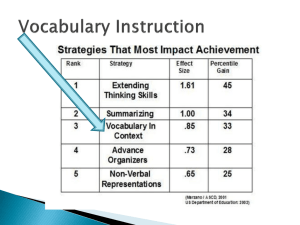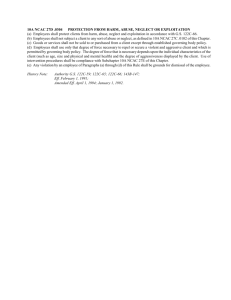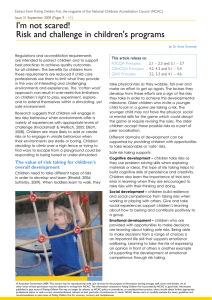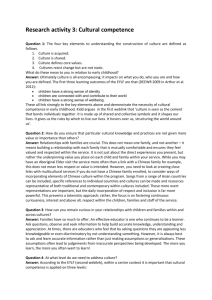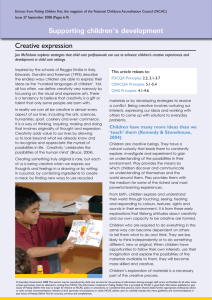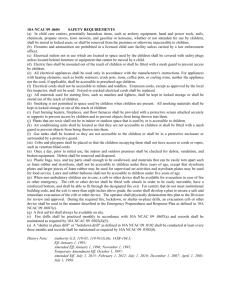Embracing diversity in families
advertisement
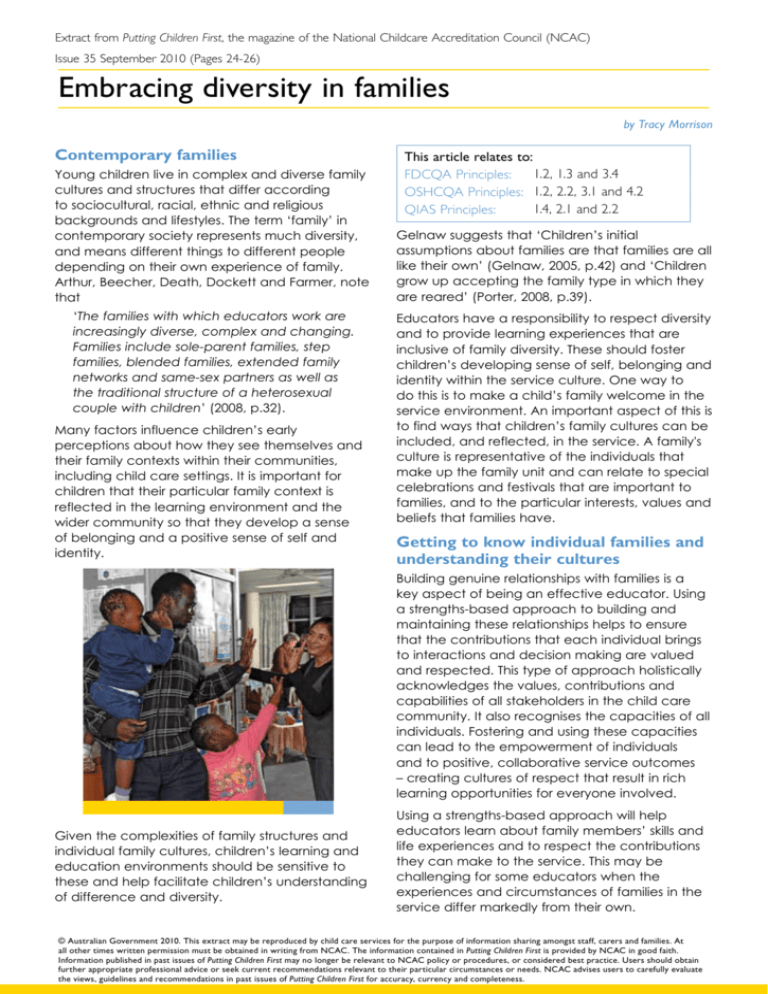
Extract from Putting Children First, the magazine of the National Childcare Accreditation Council (NCAC) Issue 35 September 2010 (Pages 24-26) Embracing diversity in families by Tracy Morrison Contemporary families Young children live in complex and diverse family cultures and structures that differ according to sociocultural, racial, ethnic and religious backgrounds and lifestyles. The term ‘family’ in contemporary society represents much diversity, and means different things to different people depending on their own experience of family. Arthur, Beecher, Death, Dockett and Farmer, note that ‘The families with which educators work are increasingly diverse, complex and changing. Families include sole-parent families, step families, blended families, extended family networks and same-sex partners as well as the traditional structure of a heterosexual couple with children’ (2008, p.32). Many factors influence children’s early perceptions about how they see themselves and their family contexts within their communities, including child care settings. It is important for children that their particular family context is reflected in the learning environment and the wider community so that they develop a sense of belonging and a positive sense of self and identity. This article relates to: 1.2, 1.3 and 3.4 FDCQA Principles: OSHCQA Principles: 1.2, 2.2, 3.1 and 4.2 1.4, 2.1 and 2.2 QIAS Principles: Gelnaw suggests that ‘Children’s initial assumptions about families are that families are all like their own’ (Gelnaw, 2005, p.42) and ‘Children grow up accepting the family type in which they are reared’ (Porter, 2008, p.39). Educators have a responsibility to respect diversity and to provide learning experiences that are inclusive of family diversity. These should foster children’s developing sense of self, belonging and identity within the service culture. One way to do this is to make a child’s family welcome in the service environment. An important aspect of this is to find ways that children’s family cultures can be included, and reflected, in the service. A family's culture is representative of the individuals that make up the family unit and can relate to special celebrations and festivals that are important to families, and to the particular interests, values and beliefs that families have. Getting to know individual families and understanding their cultures Building genuine relationships with families is a key aspect of being an effective educator. Using a strengths-based approach to building and maintaining these relationships helps to ensure that the contributions that each individual brings to interactions and decision making are valued and respected. This type of approach holistically acknowledges the values, contributions and capabilities of all stakeholders in the child care community. It also recognises the capacities of all individuals. Fostering and using these capacities can lead to the empowerment of individuals and to positive, collaborative service outcomes – creating cultures of respect that result in rich learning opportunities for everyone involved. Given the complexities of family structures and individual family cultures, children’s learning and education environments should be sensitive to these and help facilitate children’s understanding of difference and diversity. Using a strengths-based approach will help educators learn about family members’ skills and life experiences and to respect the contributions they can make to the service. This may be challenging for some educators when the experiences and circumstances of families in the service differ markedly from their own. © Australian Government 2010. This extract may be reproduced by child care services for the purpose of information sharing amongst staff, carers and families. At all other times written permission must be obtained in writing from NCAC. The information contained in Putting Children First is provided by NCAC in good faith. Information published in past issues of Putting Children First may no longer be relevant to NCAC policy or procedures, or considered best practice. Users should obtain further appropriate professional advice or seek current recommendations relevant to their particular circumstances or needs. NCAC advises users to carefully evaluate the views, guidelines and recommendations in past issues of Putting Children First for accuracy, currency and completeness. Extract from Putting Children First, the magazine of the National Childcare Accreditation Council (NCAC) Issue 35 September 2010 (Pages 24-26) However, acknowledging this diversity positively can provide opportunities for educators to reflect on their ability to respect differences, and to question their long held beliefs and assumptions about what constitutes a family unit. Reflective questions Educators need to feel comfortable talking about differences in family structures so that children and other families can do this too. Attitudes should be explored in ways that will support an acceptance of diversity and result in inclusive practices. • What gives a family its particular ‘culture’? Child care educators need to be respectful and supportive of individual families and the experiences that challenge and interest them. To do this in an inclusive way educators demonstrate respect for all elements of family's cultures, including their practices, rituals, beliefs and values. Discussing these with families when the need arises is also a way to show families respect, along with including such elements of these in the programs. Genuinely inclusive learning and teaching environments help children to feel accepted, and valued. Feelings of acceptance result in individuals feeling empowered and having an increased ability to understand the need to accept others regardless of difference. ‘In order for a child to feel valued, included, respected, and welcomed, they must know that their family is’ (Gelnaw, 2005, p.42). Documenting information from families If families feel understood, respected and welcomed into the learning environment they will be more likely to share information with educators that can be used to enhance individual and group learning experiences. ‘Inclusive day-to-day practices within your classroom will communicate more effectively than any other means that you honour diversity’ (Porter, 2008, p.35). One way to enhance relationships with families and learn about their family culture is to invite family members to share time and experiences in the service. Gelnaw states that ‘encouraging parent volunteering and making your centre a comfortable and welcoming place for parents creates endless opportunities for children to experience sameness and difference’ (2005, p.44). Possible strategies for encouraging families to share information that can be documented to support programming and evaluation include • Employ active listening techniques when talking To evaluate how an inclusive culture is encouraged and communicated to all individuals, educators may find it helpful to consider the following questions: • What strategies are used to get to know individual families and gain understanding about family circumstances respectfully and sensitively? • How are partnerships between families and educators reflected on, developed and maintained? • How are family cultures and circumstances reflected meaningfully in the service environment to create a sense of belonging for families and children? • How are children’s learning experiences connected to their family’s culture? • How are opportunities created for all individuals to explore the similarities and diversity within children’s lives, cultures and family structures? • How are the questions asked by young children in relation to family differences answered? • Are resources inclusive and supportive of diverse family structures and do these encourage critical thinking about difference? • Will children at the service see their own situations reflected and feel included in the service culture and affirmed as a result? • How are the differences of individual family structures taken into account when planning special events or celebrations? to families about their children and family experiences. This information can be recorded in individual files to support relationships with children and families. Using this information to plan for individual children will communicate to families that their input and contribution is valued •E valuate what strategies educators use to encourage families to share their knowledge and expertise about their children and their family's culture. How often are families encouraged to share information with educators and when they do, how is this incorporated into learning experiences? © Australian Government 2010. This extract may be reproduced by child care services for the purpose of information sharing amongst staff, carers and families. At all other times written permission must be obtained in writing from NCAC. The information contained in Putting Children First is provided by NCAC in good faith. Information published in past issues of Putting Children First may no longer be relevant to NCAC policy or procedures, or considered best practice. Users should obtain further appropriate professional advice or seek current recommendations relevant to their particular circumstances or needs. NCAC advises users to carefully evaluate the views, guidelines and recommendations in past issues of Putting Children First for accuracy, currency and completeness. Extract from Putting Children First, the magazine of the National Childcare Accreditation Council (NCAC) Issue 35 September 2010 (Pages 24-26) Conclusion •E ncourage families to spend time in the service and to share elements of their family culture in the children's program •C reate photographic displays depicting family involvement in the life of the service to encourage further involvement and create a sense of belonging and community that includes family cultures • Invite families to document their family experiences and interests in a variety of forums to help educators learn about families and their experiences, for example, email, notice boards, surveys, newsletters. Different families will feel comfortable using different communication mediums. Encouraging educators to build on their understandings about family structures and their associated richness, differences and similarities, will help them build and maintain genuine relationships with families, plan for individual children and support families contribute to learning experiences and environments. Using a strengths-based approach will communicate to families that their input is valuable and sought after and result in shared and collaborated learning experiences. Ensuring that children’s family cultures feature in the daily life of the service environment will help create a sense of belonging for individual children and families and enrich the service community ■ This article relates to EYLF Learning: • Outcome 1: Children have a strong sense of identity •O utcome 2: Children are connected with and contribute to their world References and further reading • Arthur, L., Beecher, B., Death, E., Dockett, S., & Farmer, S. (2008). Programming and planning in early childhood settings (4 th ed.). Southbank, Victoria: Thomson. • Bowes, J., & Grace, R. (Eds). (2009). Children, families and communities: Contexts and consequences (3rd ed.). Victoria: Oxford University Press. • Elliot, R. (2005). Engaging families: building strong communication. AECA Research in Practice Series, 12(2). ACT: Australian Early Childhood Association. • Fleer, M., Edwards, S., Hammer, M., Kennedy, A., Ridgway, A., Robbins, J., & Suman, L. (2006). Early childhood learning communities: Sociocultural research in practice. NSW: Pearson/Preston Hall. • Gelnaw, A. (2005). Belonging: Including children of gay and lesbian parents - and all children – in your program. Child Care Exchange, May-June, 42-45. • Gonzalez-Mena, J. (2007). 50 early childhood strategies for working and communicating with diverse families. New Jersey: Merrill/Prentice Hall. • Gonzalez-Mena, J., & Stonehouse, A. (2004). Making links: A collaborative approach to planning and practice in early childhood. Castle Hill, NSW: Pademelon Press. • Koralek, D. (Ed). (2007). Spotlight on young children and families. Washington: NAEYC. • Porter, L. (2008). Teacher-parent collaboration: early childhood to adolescence. Victoria: ACER Press. • McCashen, W. (2005). The strengths approach: A strengths-based resource for sharing power and creating change. Bendigo, Victoria: St Luke’s Innovative Resources. • Whalley, M. (2009). Involving parents in their children’s learning (2nd ed.). Los Angeles: Sage. © Australian Government 2010. This extract may be reproduced by child care services for the purpose of information sharing amongst staff, carers and families. At all other times written permission must be obtained in writing from NCAC. The information contained in Putting Children First is provided by NCAC in good faith. Information published in past issues of Putting Children First may no longer be relevant to NCAC policy or procedures, or considered best practice. Users should obtain further appropriate professional advice or seek current recommendations relevant to their particular circumstances or needs. NCAC advises users to carefully evaluate the views, guidelines and recommendations in past issues of Putting Children First for accuracy, currency and completeness.
